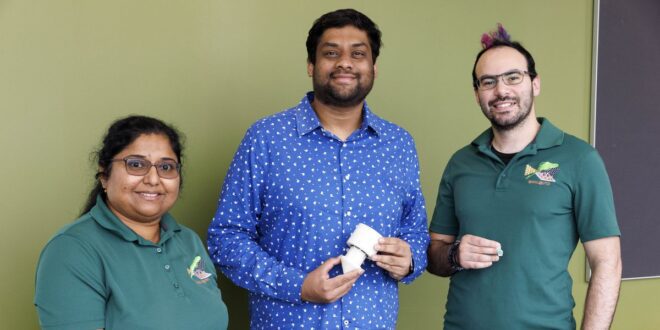To know if your soil is healthy, you need to dig in and get dirty — literally.
That’s why Dr. Shalini Prasad, a professor of bioengineering at UT Dallas, creates cutting-edge soil health technology that is buried in the ground. This technology, developed by Prasad and her team and funded by the public benefit corporation Soil in Formation, consists of soil health sensors that are placed in the soil to collect data on how farming practices, such as fertilization and irrigation, are influencing soil health. These sensors measure various aspects of soil health, including pH, moisture, and nutrient availability.
The Importance of Soil Health
Healthy soil not only provides us with food but also supports ecosystems, sustains agriculture for future generations, and fights climate change by capturing carbon that would otherwise be released into the atmosphere. With climate change putting pressure on agriculture, the need for data on soil health has become more critical than ever. Prasad emphasizes the importance of providing meaningful and actionable data to a global community and believes that change must come from everyone.
Measuring Soil Health with Sensors
Traditional soil testing methods require sending samples to a lab for expensive analysis and are often conducted only once a year. Prasad’s soil health sensors, on the other hand, offer a more accessible and frequent way of collecting data. By using sensors, farmers can obtain affordable, reliable, and frequent information about their soil health. Prasad’s sensors have unique chemical coatings that react with soil when a small electrical shock is applied, allowing them to measure different aspects of soil health. Currently, the data is downloaded directly from the sensor’s chip, but Prasad hopes to develop a wireless version for streamlined data collection.
Advantages of the Sensor System
In addition to being affordable and providing frequent data, the sensor system has the advantage of measuring soil health in context. This means that the sensors measure the soil as it is, taking into account specific soil types and climates. The sensors are also designed to survive extreme weather conditions and interactions with animals.
Benefits for Sustainable Agriculture and Carbon Neutrality
Incentivizing sustainable agriculture is one of the key benefits of Prasad’s soil health sensors. Governments and organizations can use the data collected by the sensors to offer incentives to farmers based on their soil’s carbon storage capabilities. This can contribute to efforts to achieve carbon neutrality by ensuring that carbon dioxide is trapped and stored in the soil rather than released into the atmosphere. Additionally, corporations can use the data to support their claims of carbon neutrality.
The Future of Soil Health Sensors
Soil in Formation, the public benefit corporation that funds Prasad’s work, plans to market the sensors to governments and organizations for distribution to farmers. The goal is to make the sensors free to most farmers and encourage widespread adoption of sustainable agriculture practices. Prasad and her team continue to work on improving the sensor system and plan to add more sensors to measure additional attributes of soil health. By providing farmers with valuable data on soil health, Prasad hopes to enable them to make informed decisions and work towards a healthier and more sustainable future.
 Mind Uncharted Explore. Discover. Learn.
Mind Uncharted Explore. Discover. Learn.


